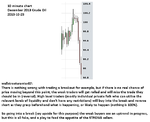lurkerlurker
Senior member
- Messages
- 2,482
- Likes
- 150
A buyer is potentially weak at the point of entry.
Let's say ES has put in a 4 point straight move. now it's at 1650. Then 3000 people buy into 1650.25, 4000 buy into 1650.50, 8000 buy into 1650.75. To simplify it, let's presume they are all new, outright long positions.
Now the market comes off 4 ticks. Those 15,000 longs are all now offside after a decent move up. They know full well they got in late and there will be some point very close below at which they will puke and their selling will help the move down.
These buyers are weak because they turn into sellers quite quickly, without much move against.
What about the buyers who go long at 1400, 1450, 1500, 1550, and fail to notice when the market runs out of steam. They turn into sellers 12-18 months later, at 1000, 900, 800, 700. Are they really any stronger than the weak buyers who turn into sellers 6 ticks lower?
Is there more to strong and weak hands than timeline and capitalisation? Out of those 15,000 longs, at least some of them will represent positions which won't be dumped 6, 60, or 600 ticks lower. So a few questions here:
-what makes a weak buyer
-how to determine when buying is weak
-how to determine what timeline the buying represents (determines when this buying becomes selling)
If someone would be willing just to draw on paint an example, of say weak buying with volume, we could then see if it is actually the volume that tells us that the buying was weak, that would be great.
Somebody should do this. WSW has made a few posts inviting comment, a chart example, and usually one was not provided. We could all learn masses from just one example of how to show weak buying. Since purchases = sales, why are we describing as "buying" rather than "selling" or "buying and selling" or more generally "transactions"? Referring to one side of the auction supposes we know who is doing what and there is a reason for focusing on this group. How to know that?
I'd post an example to get things moving, but I can't. Why? Well the first rule is I'm not allowed to talk about it...

